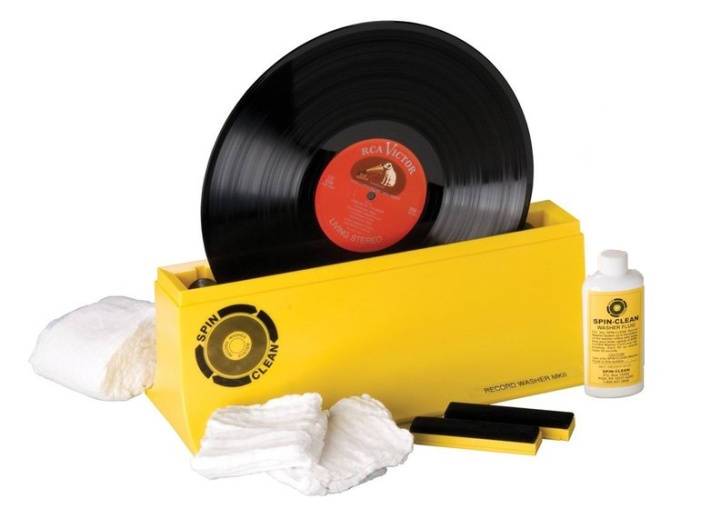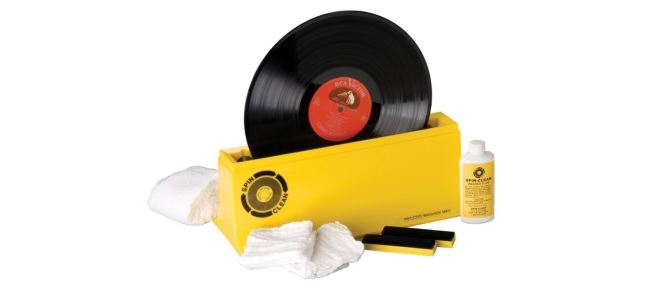
There are only three places I am aware of in Nashville where you can purchase LPs – Grimey’s New and Pre-loved Music, McKay’s Used Book Store and The Great Escape. Grimey’s sells new vinyl and has a pretty good selection of used pop and rock, though virtually no classical records. I have been over to McKay’s several times. They have a limited selection of classical records, but so far I have had good luck. The few dozen I have purchased have all been in excellent condition. As a rule, I think owners of classical music are more careful in handling their records. In addition, there is no doubt in my mind that the average classical record has been played many fewer times than the average pop record. All of them have also come with cellophane-lined paper sleeves. Unless there are obvious scratches, I feel confident buying them. A quick cleaning with my Audioquest anti-static brush to clear off the dust has been all that is needed for playback with a virtually silent background. I have not felt nearly as confident with pop records. The bulk of them look like they have been through the war, and a quick glance at their surfaces left me with a sense of dread. I have refrained from purchasing them. Last Saturday morning, Natalie and I decided to head over to The Great Escape to check out their selection. Actually it was just me. Natalie was busy record hunting with Stephen Meijas. When I arrived, the parking lot was full and there was a lot of commotion in front of the store. Turns out they were having a sidewalk sale with thousands of LPs available for twenty-five cents each. So I leapt into the fray with about two dozen other bargain hunters and began scrounging through the bins, pulling out whatever caught my eye. Most were folk and folk rock albums from the 1960’s and 1970’s which I remembered from my youth. I also picked up a few Frank Sinatra and Nat King Cole disks, and some small-scale jazz ensemble recordings. In the end, I walked back to the car with 53 albums for less than fifteen dollars, including tax, doubling my record collection in less than an hour. Truth be told though, I didn’t have high expectations.
When I got home I put a few of my discoveries on my turntable to see how they sounded. To cut to the chase, the music was competing with the sound of a bowl of Rice Krispies. It seemed like a good time to do a little research on record cleaning. What I found was that there are basically three alternatives: hand-washing, the Spin-Clean Record Washer, and expensive record cleaning machines from the likes of Clearaudio, Nitty Gritty, Okki Nokki and VPI. I decided to try hand-washing. The first dilemma was determining the best cleaning solution to use. A quick check of Google resulted in the realization that there is no consensus. In addition to the commercially available products, there were more individual concoctions than stars in the sky, each one sworn to as the last word in record cleaning by its advocate. I ended up making up a solution of distilled water, a tiny bit of dishwashing liquid, and an even smaller amount of alcohol. I used a soft nail brush to gently scrub a few records in a circular motion, rinsed them with distilled water, and dried them with a soft cloth. Result: completely ineffective. I knew that if I was going to buy used records, I would have to step up my game, so I ordered the Spin-Clean Record Washer. I had seen it demoed at RMAF, and at $79.95, it seemed like an affordable solution.
The Spin-Clean record washing system is the epitome of simplicity. It consists of a narrow plastic basin to hold the record cleaning solution, two rollers you insert at opposite ends of the basin to facilitate rotating the record, and two facing pads you place in the center of the basin which do the work of cleaning the grooves. The rollers can be placed in slots for 12”,10” and 7” records. The kit comes with an 8 ounce bottle of cleaning solution and several lint free cloths. You fill the basin with distilled water and add three capfuls of solution, which is enough to clean 50 records. At that rate, a bottle of cleaning solution will do hundreds and hundreds are records. You may never need to purchase more. The solution contains a chemical that causes the dislodged dirt to settle to the bottom of the basin, so you are not spinning your records through dirty water with each pass. Cleaning a record is straight-forward. Insert the record between the pads into the solution, spin it three revolutions, take it out, and dry it. Repeat until you are finished with your batch of records.
Cleaning 53 records took me about three hours, including set-up and clean-up, so roughly three minutes a record. It is both efficient and tedious. What were the results? Take a look at the photo below to see the filth from the records which precipitated out of the solution and floated to the bottom of the basin (pads removed for better visibilty). I was shocked at how dirty the records were. They certainly didn’t look dirty when I first took them out of their sleeves. It must have just been dust that accumulated over the years from the records sitting on the platter. I’m pretty sure smoke from various substances exacerbated the problem. Also, none of the sleeves were inserted into the record covers with the opening facing up, so in addition to allowing the records to fall out of the album covers, dust could have made its way onto the record from the open slot.
I played a few cleaned records and was amazed at the result. Not all the groove noise was eliminated, but a substantial amount was. The records are now enjoyable to listen to. I can imagine that better cared for records would be returned to like new condition.
Conclusion
The Spin-Clean record washing system is both effective and inexpensive. It is a must-have accessory for anyone contemplating buying used records. It is as simple as that. Highly recommended.
- Frank Berryman
Contact Information
Spin-Clean® International
P.O. Box 15200
Pittsburgh, PA 15237-0200
800-931-5850
http://www.spincleanrecordwasher.com
Associated Equipment
Analog Source: VPI Scout; Dynavector 20X2; Musical Surroundings Phonomena II
Digital Source: Windows 7 music server with ESI Juli@ soundcard; Halide Design Bridge
Preamplifier: Meridian G68ADV; Benchmark DAC1 HDR
Power Amplifier: Meridian 557
Loudspeakers: Meridian DSP5500; Living Sounds Audio LSA.5
Cables: Digital: Meridian; Analog and Speaker: Audience Conductor ‘e’; Power: Volex/Marinco
Headphones: Etymotic ER-4S
Accessories: GIK acoustic treatments, Target HR speaker stands, dedicated 20 amp circuit


